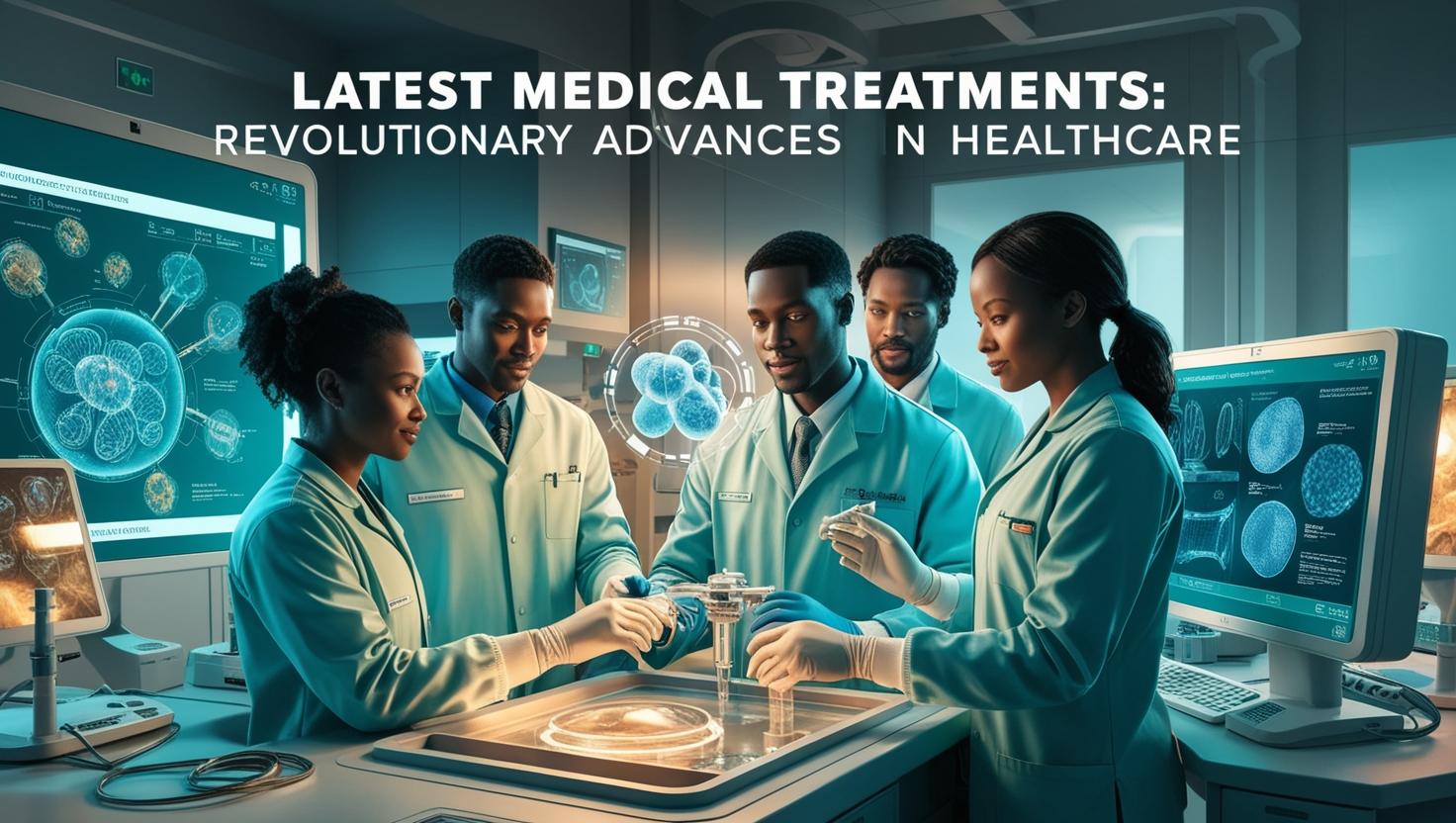Advancements in medicine bring new hope and possibilities. Innovative treatments are changing patient care daily.
Medical science never stands still. New therapies and technologies emerge, transforming how we treat diseases. These advancements promise better outcomes and improved quality of life. From cutting-edge surgeries to groundbreaking drugs, the latest medical treatments offer fresh solutions. They address complex conditions and provide new options for patients.
Understanding these innovations can empower you to make informed healthcare decisions. Dive into the world of modern medicine and discover what these treatments mean for the future of health. Stay informed and see how these advancements can impact your life or the lives of your loved ones.

Credit: www.en.turkeyhealthcaregroup.com
Introduction To Revolutionary Advances
Welcome to the fascinating world of modern medicine. Recent advances are changing how we approach health and disease. These innovations provide new hope and improved outcomes for patients worldwide. Let’s explore some of the most exciting developments in medical treatments today.
Overview Of Recent Innovations
Medical science has seen many breakthroughs in recent years. One notable advancement is gene therapy. This method targets the root cause of genetic disorders. It offers the potential to cure diseases once thought incurable. Another innovation is immunotherapy. This treatment boosts the body’s immune system to fight cancer. It shows promise in treating various types of cancer. Robotic surgery is another significant development. Robots assist surgeons, making procedures less invasive. This results in faster recovery times for patients. 3D printing technology is also making waves. It allows for the creation of customized prosthetics and even organs. These advancements are transforming the medical field.
Impact On Patient Care
The impact of these innovations on patient care is profound. Gene therapy offers hope for those with rare genetic disorders. It provides a chance for a normal life. Immunotherapy has changed the landscape of cancer treatment. Patients now have more options and better survival rates. Robotic surgery means less pain and quicker recovery. Patients spend less time in the hospital and return to their daily lives sooner. 3D printing provides tailored solutions for individual needs. This technology improves the quality of life for many patients. These advancements are not just about technology. They are about improving lives. Every innovation brings us one step closer to better health for all.
Gene Therapy Breakthroughs
Gene therapy has emerged as a promising field in modern medicine. It offers hope for treating various genetic disorders. Recent advances have shown significant potential. Scientists are now able to target and correct specific genes. This progress could change the lives of many patients.
Treating Genetic Disorders
Gene therapy targets the root cause of genetic disorders. It involves inserting, altering, or removing genes within a patient’s cells. This process can correct faulty genes. It can also introduce new genes to help fight diseases. Conditions like cystic fibrosis and muscular dystrophy are being studied. Researchers aim to provide lasting solutions for these inherited diseases.
Recent Success Stories
Many recent gene therapy trials have shown positive results. One notable success is in treating spinal muscular atrophy (SMA). SMA is a severe genetic disorder. A new gene therapy treatment has significantly improved patients’ motor functions. Another success is in treating certain types of blindness. Patients with inherited retinal diseases have regained partial vision. These breakthroughs offer new hope for those affected by genetic disorders.
Immunotherapy Progress
Immunotherapy has seen significant progress in recent years. This treatment harnesses the body’s own immune system to fight diseases, especially cancer. It offers a promising alternative to traditional methods like chemotherapy and radiation.
Cancer Treatment Advances
One of the most exciting areas of immunotherapy is its use in cancer treatment. There are several types of immunotherapy:
- Checkpoint inhibitors – These drugs help the immune system recognize and attack cancer cells.
- CAR T-cell therapy – This involves modifying a patient’s T-cells to better target cancer.
- Monoclonal antibodies – These are lab-made proteins that bind to specific targets on cancer cells.
Each type works differently but shares the same goal: to boost the body’s natural defenses against cancer. Recent clinical trials have shown positive results. For example, checkpoint inhibitors have increased survival rates for patients with melanoma and lung cancer.
Future Potential
The future of immunotherapy looks bright. Researchers are exploring new ways to enhance its effectiveness. Areas of focus include:
- Combining immunotherapy with other treatments, like chemotherapy.
- Developing vaccines that prevent cancer.
- Personalizing immunotherapy based on a patient’s genetic profile.
These advancements could lead to more effective and less toxic cancer treatments. In summary, immunotherapy represents a significant advancement in medical treatments. Its progress in cancer treatment offers hope for many patients. The future holds even more potential as research continues to evolve.
Crispr Technology
CRISPR Technology stands for Clustered Regularly Interspaced Short Palindromic Repeats. It is a powerful tool used for editing genomes. Scientists can alter DNA sequences and modify gene function. This technology has opened new doors in medical research and treatments.
Genome Editing Applications
CRISPR has many applications in genome editing. It can target and edit specific genes. This helps in correcting genetic defects. It can treat and prevent many diseases. For example, CRISPR can be used in treating cancer. It can also help in curing genetic disorders. Researchers are exploring its potential in various fields. Another application is in agriculture. CRISPR can create crops resistant to pests. This increases yield and reduces the need for pesticides. The technology’s precision makes it very effective.
Ethical Considerations
CRISPR technology raises many ethical questions. Editing human genes can have unforeseen consequences. There is a debate about the morality of genetic modifications. Some worry about the potential for “designer babies.” This means altering genes for desired traits. There are concerns about the accessibility of CRISPR. Not everyone may have equal access to this technology. This could lead to social inequality. The long-term effects of gene editing are still unknown. It is important to proceed with caution.
Telemedicine Expansion
In recent years, telemedicine has become a crucial part of healthcare. The COVID-19 pandemic accelerated its growth, making it essential for doctors and patients. Telemedicine offers a way to consult with healthcare providers without leaving home. This has led to the expansion of various services, including remote patient monitoring.
Remote Patient Monitoring
Remote patient monitoring (RPM) uses technology to track patients’ health data from a distance. Devices like wearables and sensors collect information on heart rate, blood pressure, and glucose levels. This data is then sent to healthcare providers in real-time. RPM helps doctors keep an eye on chronic conditions. It also allows for timely interventions if any abnormal signs are detected. This continuous monitoring can improve patient outcomes and reduce hospital visits.
Benefits And Challenges
Telemedicine brings many benefits to patients and healthcare providers. Here are some key advantages:
- Convenient access to care
- Reduced need for travel
- Lower healthcare costs
- Better management of chronic diseases
Despite the advantages, telemedicine also presents some challenges:
- Limited access to technology for some patients
- Privacy and security concerns
- Need for reliable internet connections
- Possible lack of personal interaction
To address these challenges, healthcare providers must ensure that telemedicine services are accessible and secure. They should also provide support to patients unfamiliar with technology.
| Benefits | Challenges |
|---|---|
| Convenient access to care | Limited access to technology |
| Reduced need for travel | Privacy and security concerns |
| Lower healthcare costs | Need for reliable internet connections |
| Better management of chronic diseases | Possible lack of personal interaction |
With the right approach, telemedicine can transform healthcare. It can make medical services more accessible and efficient. As technology continues to evolve, we can expect even more innovations in this field.

Credit: lonadiersmobiledetailing.com
Artificial Intelligence In Diagnosis
Artificial Intelligence helps doctors find diseases faster and more accurately. It helps in creating better treatment plans for patients. This leads to improved health outcomes.
Artificial Intelligence (AI) in diagnosis is transforming the medical field. AI uses advanced algorithms to analyze data. It helps doctors make more accurate diagnoses.
Ai-powered Tools
AI-powered tools are changing medical diagnosis. These tools analyze large amounts of data quickly. They can read and interpret medical images. They can detect patterns and anomalies in seconds. Doctors use AI tools to examine X-rays and MRIs. AI can spot tiny details that humans might miss. This leads to more accurate results.
Improving Accuracy And Speed
AI improves the accuracy of medical diagnoses. It reduces human error. AI algorithms learn from vast amounts of data. They improve over time with more data. Speed is another benefit of AI in diagnosis. AI processes information faster than humans. This speeds up diagnosis and treatment. Early diagnosis means better patient outcomes. AI tools help doctors make quicker decisions. This can save lives.
3d Printing In Medicine
3D printing is transforming medicine. It offers precise and personalized treatments. This technology is used in many areas. From creating custom implants to exploring future possibilities, 3D printing is making waves.
Custom Implants And Prosthetics
3D printing is key in making custom implants and prosthetics. These are tailored to fit individual patients. This ensures better comfort and functionality. It reduces the need for adjustments after surgery. Doctors use 3D scans of patients. These scans help in designing implants that match the patient’s anatomy. This approach is more efficient. It also speeds up the recovery process. Patients experience less pain and complications.
Future Possibilities
The future of 3D printing in medicine is bright. Researchers are exploring new ways to use this technology. One area of interest is bioprinting. This involves printing tissues and organs. It could solve the organ donation crisis. Another possibility is printing personalized medications. This would allow for precise dosages. It would reduce side effects and improve effectiveness. The potential applications are endless. As technology advances, the medical field will continue to benefit.

Credit: www.styku.com
Personalized Medicine
Personalized medicine represents a shift in medical treatments. It tailors healthcare to individual patients based on their genetic makeup. Unlike traditional approaches, this method considers unique biological factors. Personalized medicine aims to provide more effective and targeted treatments.
Tailored Treatments
Tailored treatments focus on each patient’s specific needs. Doctors use genetic information to design the best therapy. This approach can minimize side effects and improve treatment success. For example, cancer therapies can target only cancer cells, sparing healthy ones. Tailored treatments also consider lifestyle and environment. These factors play a role in how patients respond to medication. By addressing these aspects, healthcare providers can offer more precise treatments. This leads to better patient care and outcomes.
Patient Outcomes
Personalized medicine improves patient outcomes significantly. Patients receive treatments designed specifically for them. This increases the chances of success. It also reduces the risk of adverse reactions. Patients often experience faster recovery times. Another benefit is the prevention of diseases. Genetic screening can identify potential health issues early. This allows for proactive measures to manage or prevent illnesses. Personalized medicine offers a more effective and efficient healthcare experience.
Robotics In Surgery
The field of surgery has seen significant advancements with the integration of robotics. These robotic systems assist surgeons in performing complex procedures with greater ease and precision. With the help of robotics, surgeries have become less invasive and more efficient, benefiting both patients and medical professionals.
Minimally Invasive Techniques
Robotic systems enable minimally invasive techniques in surgery. Surgeons can make smaller incisions, reducing recovery time. Patients experience less pain and fewer complications. The use of robotic arms allows for precise movements, which are crucial in delicate procedures. Minimally invasive techniques also mean shorter hospital stays. This leads to lower healthcare costs. The benefits extend to a quicker return to normal activities for patients.
Enhanced Precision
Robotics in surgery offer enhanced precision. Surgeons control robotic arms with high accuracy. This reduces the risk of human error. The robotic systems provide a magnified view of the surgical area. This enables surgeons to see details that are not visible to the naked eye. Enhanced precision is particularly important in surgeries involving vital organs. It ensures that only the targeted area is affected, preserving healthy tissues. The combination of robotic precision and surgeon expertise results in better surgical outcomes.
Frequently Asked Questions
What Are The Latest Medical Treatments In 2023?
In 2023, advancements include gene therapy, immunotherapy, and personalized medicine. These treatments target specific diseases with high precision and effectiveness.
How Does Gene Therapy Work?
Gene therapy involves modifying genes to treat or prevent diseases. It targets the root cause by repairing or replacing defective genes.
What Is Immunotherapy Used For?
Immunotherapy boosts the body’s immune system to fight cancer. It helps recognize and attack cancer cells more effectively.
Are Personalized Medicines Effective?
Yes, personalized medicines are tailored to individual genetic profiles. They offer more precise and effective treatment options for patients.
Conclusion
Exploring the latest medical treatments is crucial. These advancements offer new hope. Patients can benefit from cutting-edge therapies. Improved treatment options mean better outcomes. Staying informed helps in making better choices. Consult your doctor about these latest treatments. Your health is important.
Keep learning and stay proactive. The future of medicine looks promising. Stay positive and informed. Your well-being matters most.
